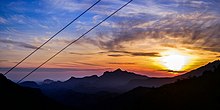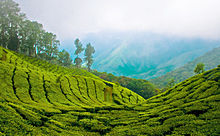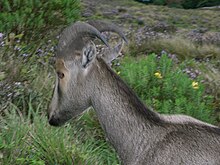Munnar
 From Wikipedia - Reading time: 14 min
From Wikipedia - Reading time: 14 min
Munnar | |
|---|---|
 A view of Munnar | |
| Nickname: The Kashmir of South India | |
| Coordinates: 10°05′21″N 77°03′35″E / 10.08917°N 77.05972°E | |
| Country | India |
| State | Kerala |
| District | Idukki |
| Taluk | Devikulam |
| Named for | Tea plantations, cool climate |
| Government | |
| • Type | Grama Panchayat |
| • Body | Munnar grama panchayath |
| Area | |
• Total | 187 km2 (72 sq mi) |
| Elevation | 1,532 m (5,026 ft) |
| Population (2011) | |
• Total | 32,029 |
| • Density | 170/km2 (440/sq mi) |
| Languages | |
| • Official | Malayalam[2] |
| • Regional | Tamil,[3] Malayalam |
| Time zone | UTC+5:30 (IST) |
| PIN | 685612 |
| Telephone code | 04865 |
| Vehicle registration | KL-68, KL-06 |
| Literacy | 84.9% |
| Website | keralatourism |
Munnar (IPA: [muːn̪ːɐːr]) is a town and hill station located in the Idukki district of the southwestern Indian state of Kerala. Munnar is situated at around 1,600 metres (5,200 ft) above mean sea level,[4] in the Western Ghats mountain range. Munnar is also called the "Kashmir of South India" and is a popular honeymoon destination.
Etymology
[edit]The name Munnar is a combination of the words "Munnu" and "Aaru" in the local languages of Malayalam/Tamil meaning "three rivers",[5] referring to its location at the confluence of the Muthirapuzha, Nallathanni and Kundali rivers.[6]
History
[edit]

The region has been inhabited by hunter-gatherer tribals like the Malayarayan and Muthuvan for thousands of years.[7] In the early days, only Tamils and few Malayalis lived there. They were brought as workers in the tea plantations. Tradition states that Colonel Arthur Wellesley, later the Duke of Wellington, was the first British person to pass through Munnar during Tipu Sultan's campaign in Travancore, but this is unsubstantiated. The first survey of the terrain was undertaken by Benjamin Swayne Ward in 1816–1817, who followed Periyar into the Western Ghats and established a camp at the confluence of three rivers, from which the name of Munnar is derived.[8]
It was to be nearly 50 years later that Sir Charles Trevelyan, Governor of Madras, instructed Col. Douglas Hamilton to explore the hill country in the western part of the Madras Presidency, requesting special advice on the feasibility of establishing sanatoria for the British in the South and of developing revenue- earning projects without endangering the environment, as had happened in Ceylon where coffee had destroyed not only the rain forest but also paddy cultivation in the north-central rice bowl of ancient Ceylon. Hamilton climbed throughout the Ghats in Munnar region. 15 years later, John Daniel Munro noted that much of Munnar's land was suitable for coffee plantations. Munro, Henry Turn and his half-brother AW Turner obtained ownership of the Cardamom Hills from the Raja of Travancore and began clearing forest around Devikulam in 1879. Soon many other Europeans began establishing tea plantations in the area throughout the 1880s. Early plantations had few facilities and were mainly huts of straw.
Eventually roads were opened to the lowlands and in Bodinayakanur in western Madras Presidency, planters got provisions from a local headman - Suppan Chetty. He and his son, Alaganan Chetty (later an MLA) would continue providing supplies to the tea estates in the region. By 1894, 26 estates were established in the hills, but all were facing losses. In 1897, a separate company, Kannan Devan Hills Corporation (KDHC) was registered to operate the tea estates which was later taken over by the American Direct Tea Trading Company Ltd., who owned 26 estates, most with coffee and some with cinchona, almost all in the area except for a few in the lower areas.
In 1900, a ropeway was built and eventually monorails were installed for easier transport of goods to the plains. In 1901, P. R. Buchanan took over as General Manager and began the most extensive clearing of jungles for plantations. In 1908, construction started on a new railway which opened in 1909. By 1911, around 16,000 acres of the region was under cultivation.
In 1924, a flood swept through Munnar, damaged the road and destroyed the rail track. In its place it was decided to create a ropeway to transport tea. In 1930, this in turn was replaced by a modern road that made transport much easier. By 1952, almost 28,000 acres of land was under cultivation. After Independence, Indian planters took over. In 1964, the KDHC which owned most tea estates was acquired by Tata and Finlay who started the first instant tea factory in the country. In 1971, the Kerala government wanted to reforest all land in the hills not used for plantations. However, negotiations that followed resulted in Tata keeping most of the land, leaving it with 57,000 acres.
To this day, most tea estate labourers are landless. In the early 2000s, the Viduthalai Chiruthaigal Katchi, a Dalit outfit from Tamil Nadu, started demanding land for the labourers, started making inroads into Kerala. In 2009, VS Achuthanandan promised his support for providing land to the mainly Tamil Dalit estate labourers. However, the process became very slow and as of 2018, most families still hand no land.[9]
The former Kunda Valley Railway in Munnar was destroyed by a flood in 1924, but tourism officials are considering reconstructing the railway line to attract tourists.[10]
Geography
[edit]The region in and around Munnar varies in height from 1,450 meters (4,760 ft) to 2,695 meters (8,842 ft) above mean sea level. The temperature ranges between 5 °C (41 °F) and 25 °C (77 °F) in winter and 15 °C (59 °F) and 25 °C (77 °F) in summer.[11] Temperatures as low as −4 °C (25 °F) have been recorded in the Sevenmallay region of Munnar.[12][failed verification][failed verification]
Köppen-Geiger climate classification system classifies it as subtropical highland (Cwb).[13]
| Climate data for Munnar | |||||||||||||
|---|---|---|---|---|---|---|---|---|---|---|---|---|---|
| Month | Jan | Feb | Mar | Apr | May | Jun | Jul | Aug | Sep | Oct | Nov | Dec | Year |
| Mean daily maximum °C (°F) | 22.4 (72.3) |
23.7 (74.7) |
25.3 (77.5) |
25.6 (78.1) |
25.6 (78.1) |
23.7 (74.7) |
22.4 (72.3) |
22.8 (73.0) |
23.2 (73.8) |
22.7 (72.9) |
21.8 (71.2) |
21.9 (71.4) |
23.4 (74.2) |
| Daily mean °C (°F) | 17.6 (63.7) |
18.7 (65.7) |
20.2 (68.4) |
21 (70) |
21.4 (70.5) |
20.3 (68.5) |
19.3 (66.7) |
19.5 (67.1) |
19.6 (67.3) |
19.2 (66.6) |
18.3 (64.9) |
17.7 (63.9) |
19.4 (66.9) |
| Mean daily minimum °C (°F) | 12.9 (55.2) |
13.7 (56.7) |
15.1 (59.2) |
16.5 (61.7) |
17.3 (63.1) |
16.9 (62.4) |
16.3 (61.3) |
16.3 (61.3) |
16 (61) |
15.7 (60.3) |
14.8 (58.6) |
13.5 (56.3) |
15.4 (59.8) |
| Average precipitation mm (inches) | 18 (0.7) |
29 (1.1) |
47 (1.9) |
129 (5.1) |
189 (7.4) |
420 (16.5) |
583 (23.0) |
364 (14.3) |
210 (8.3) |
253 (10.0) |
164 (6.5) |
64 (2.5) |
2,470 (97.3) |
| Average rainy days | 2 | 2 | 3 | 6 | 8 | 9 | 10 | 9 | 10 | 12 | 8 | 5 | 84 |
| Mean monthly sunshine hours | 248 | 232 | 248 | 240 | 217 | 120 | 124 | 124 | 150 | 155 | 180 | 217 | 2,255 |
| Source 1: Climate-Data.org, altitude: 1461m[13] | |||||||||||||
| Source 2: Weather2Travel for sunshine and rainy days[14] | |||||||||||||

Transportation
[edit]Road
[edit]
Munnar is well connected by both National highways, state highways and rural roads. The town lies in the Kochi - Dhanushkodi National highway (N.H 49), about 130 km (81 mi) from Cochin, 31 km (19 mi) from Adimali, 85 km (53 mi) from Udumalpettu in Tamil Nadu and 60 km (37 mi) from Neriyamangalam.
Distance from major cities & tourist destinations.
- Aluva - 109 km
- Varkala - 245 km
- Trivandrum - 280 km
- from Kochi - Ernakulam - 150 km
Railway
[edit]The nearest railway station is Bodinayakkanur (68 km) in Tamil Nadu and nearest major railway stations in Kerala are at Ernakulam (126 km) and Aluva (110 km).
Kerala State Road Transport Corporation (KSRTC) bus stand is in walking distance from Aluva Railway Station, and buses are available for Munnar every hour.
Airport
[edit]The nearest airport is Cochin International Airport, which is 110 kilometres (68 mi) away. The Coimbatore and Madurai airports are 165 kilometres (103 mi) from Munnar.
Administration
[edit]The Panchayat of Munnar formed on January 24, 1961, is divided into 21 wards for administrative convenience. Coimbatore district lies to the north, Pallivasal to the south, Devikulam and Marayoor to the east, and Mankulam and Kuttampuzha Panchayats to the west.
Demographics
[edit]According to the 2011 Census, Munnar Grama Panchayat had a total population of 32,039. 16,061 were males and 15,968 were females, with 7,968 families total residing therein. Children represented in the age group of 0-6 were 2,916 (9.1% of the total population), which constitutes 1,478 males and 1,438 females. Munnar Panchayat had an overall literacy rate of 84.85%, substantially lower than the Kerala state average of 94.00%. Male literacy stands at 91.05% and female literacy at 78.64%.[15]
Flora and fauna
[edit]
Most of the native flora and fauna of Munnar have disappeared due to severe habitat fragmentation resultant from the creation of the plantations. However, some species continue to survive and thrive in several protected areas nearby, including the new Kurinjimala Sanctuary to the east, the Chinnar Wildlife Sanctuary, Manjampatti Valley and the Amaravati reserve forest of Indira Gandhi Wildlife Sanctuary to the north east, the Eravikulam National Park and Anamudi Shola National Park to the north, the Pampadum Shola National Park to the south and the proposed Palani Hills National Park to the east.
Endemic species
[edit]
These protected areas are especially known for several threatened and endemic species including Nilgiri Thar, the grizzled giant squirrel, the Nilgiri wood-pigeon, elephant, the gaur, the Nilgiri langur, the sambar, and the Neelakurinji (that blossoms only once in twelve years).[16][17]
Land ownership
[edit]There has been action to address the problems of property takeovers by the land mafia that have, according to successive governments, plagued the area. In 2011, the government estimated that 20,000 hectares of land had been illegally appropriated and launched a campaign of evictions that had first been mooted in 2007.[18]
See also
[edit]- Bisonvalley
- Kolukkumalai
- Kunchithanny
- Marayur
- Mattupetty Dam
- Munnar Tea Museum
- 2015 Munnar Plantation strike
- Pallivasal
- Rajakkad
- Wayanad
References
[edit]- ^ Munnar - Fallingrain
- ^ "The Kerala Official Language (Legislation) Act, 1969" (PDF).
- ^ "Table C-16 Population by Mother Tongue: Kerala". www.censusindia.gov.in. Registrar General and Census Commissioner of India.
- ^ "Munnar - the Hill Station of Kerala in Idukki | Kerala Tourism". Archived from the original on 18 January 2014. Retrieved 21 June 2012.
- ^ Munnar History Archived 5 February 2012 at the Wayback Machine
- ^ "Munnar". Archived from the original on 18 January 2014. Retrieved 21 June 2012.
- ^ "How the original inhabitants of Idukki were systematically displaced and deceived". OnManorama. Retrieved 28 January 2021.
- ^ S, Muthiah (1993). A Planting Century 1893-1993. Madras: -West Pvt Ltd., 62-A Ormes Road, Kilpauk, Madras-600010. ISBN 81-85938-04-0.
- ^ Tamilarasu, Prabhakar (13 August 2020). "The 'no land's men' in Munnar's tea estates". The Federal. Retrieved 28 January 2021.
- ^ Abraham, Bobins (24 June 2019). "Munnar May Soon Get Train Service, Nearly A Century After The 'Great Flood Of 99' Destroyed It". indiatimes.com. Retrieved 24 June 2019.
- ^ "Management Plan". Eravikulam National Park. Archived from the original on 12 May 2006. Retrieved 28 August 2013.
- ^ "Frost hits plantations in Munnar". The Hindu. Archived from the original on 13 March 2004.
- ^ a b "Climate: Munnar — Climate graph, Temperature graph, Climate table". Climate-Data.org. Retrieved 28 August 2013.
- ^ "Munnar Climate and Weather Averages, Kerala". Weather2Travel. Retrieved 28 August 2013.
- ^ Kerala, Directorate of Census Operations. District Census Handbook, Idukki (PDF). Thiruvananthapuram: Directorate of Census Operations, Kerala. p. 92,93. Retrieved 14 July 2020.
- ^ "Government of Kerala, Forest and Wildlife Department, Notification No. 36/2006 F&WLD". Kerala Gazette. 6 October 2006. Archived from the original on 30 December 2007. Retrieved 5 December 2007.
- ^ Roy, Mathew (25 September 2006). "Proposal for Kurinjimala sanctuary awaits Cabinet nod". The Hindu. Archived from the original on 1 October 2007. Retrieved 5 December 2007.
- ^ Jacob, Jeemon (12 July 2011). "Kerala government launches eviction drive in Munnar". Archived from the original on 27 August 2012. Retrieved 10 July 2014.
 KSF
KSF
